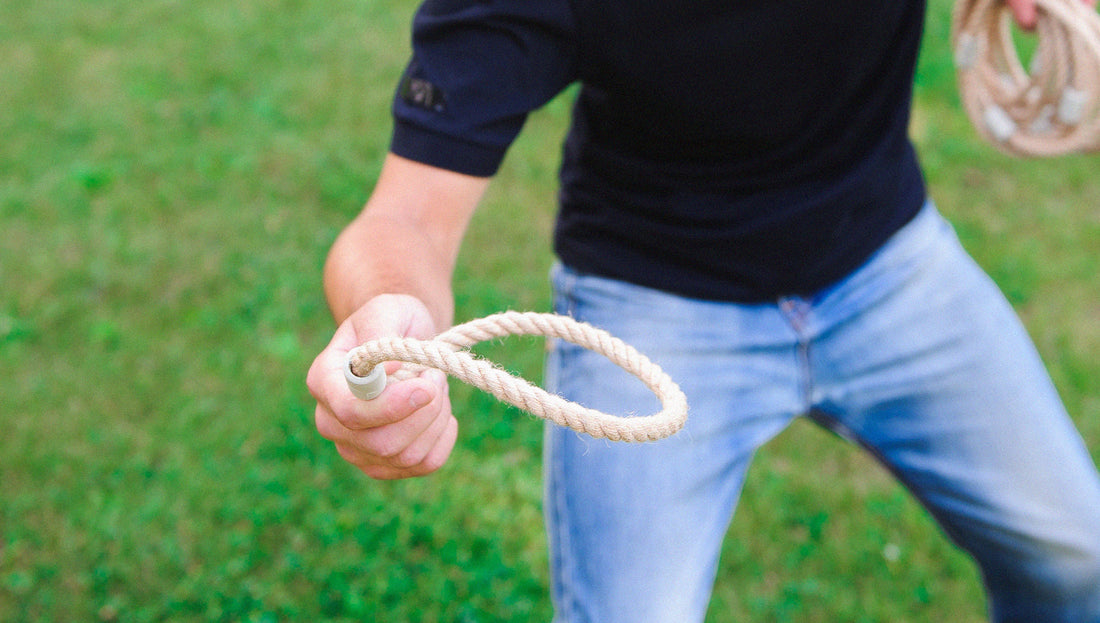History and Origins:
Quoits, originating in ancient Greece, boasts a rich history and cultural tradition. In ancient times, Greek warriors refined their accuracy and precision by hurling metal rings at stakes or spikes, a practice that served as both entertainment and training. Over the centuries, quoits evolved beyond and spread across Europe. In medieval England, amidst the Middle Ages, quoits thrived as a popular pastime. Communities embraced the game passionately, with each region contributing its own distinct rules and equipment, resulting in a diverse set of local variations.
How To Play Ring Toss or Quoits:
Quoits is loved for its simplicity and accessibility, appealing to players of all ages and backgrounds. The game revolves around tossing rings or discs, called quoits, toward a target—usually a raised stake in the ground. The goal is straightforward: aim for accuracy and precision to earn points based on proximity to the target. A "ringer," where the quoit circles the stake, scores the highest. Whether played casually at backyard gatherings or in competitive tournaments, quoits sparks family-friendly competition among players.
Step By Step Rules:
Setup the Pitch: Start by setting up the playing area, known as the pitch. Typically, this involves placing a central stake or pin firmly into the ground. The distance between players and the stake can vary depending on the version of quoits being played. Our licensed Quoits game features a built-in stake and base so you’re ready to play out of the box!
Divide into Teams or Players: Decide on the number of players or teams participating in the game. Quoits can be played one-on-one or in teams of two or more.
Determine Scoring: Before starting, establish the scoring system. In most variations, points are awarded based on the proximity of the quoits to the stake, but feel free to evoke house rules for an added twist!
Scoring opportunities:
Close Quoit:
- A quoit that lands on the target or encircles it is considered a "close quoit." Typically, a close quoit earns the player a set number of points, often ranging from 1 to 3, depending on the game's rules.
Ringer:
- A ringer occurs when a quoit lands perfectly around the pin or stake without touching the ground. A ringer usually scores the highest points in quoits, often ranging from 3 to 5 points, or more, depending on house rules.
Leaner:
- A leaner is when a quoit lands in such a way that it leans against the pin or stake without encircling it completely. In some variations, leaners may score fewer points than close quoits, typically 1 or 2 points.
Toucher:
- A toucher is a quoit that touches the pin or stake but does not encircle it. Depending on the rules, touchers may score points, typically 1 or 2 points, or they may not score any points at all.
Missing:
- Quoits that miss the target altogether do not score any points.
Canceling Out:
- In some variations of quoits, if a player throws a quoit that displaces an opponent's quoit from a higher-scoring position, the opponent's quoit may be canceled out, and no points are scored for that quoit.
Continuing The Turn:
Decide Turn Order: Determine the order in which players or teams will take turns throwing their quoits. This can be done through a simple coin toss or by some other agreed-upon method.
Throwing the Quoits: Each player or team takes turns throwing their quoits towards the stake. Players must stand behind a designated throwing line while making their throws. Experiment with different arcs, speed, spin or however else you think you can master the toss.
Scoring: After all quoits have been thrown, total the scoring for the round based on the proximity factors mentioned above.
Tally Scores: Keep track of each player or team's score throughout the game. The game typically consists of multiple rounds, with the winner being the player or team with the highest total score at the end.
Play Continues: Continue playing additional rounds until a predetermined winning score is reached, or a set number of rounds have been completed.
Declare a Winner: Once the game is concluded, declare the winner based on the total scores accumulated throughout the game.
Popularity and Resurgence:
Despite a decline in popularity during the mid-20th century, quoits have seen a remarkable comeback in recent years. Its simplicity, accessibility, and nostalgic appeal have contributed to this resurgence. Modern versions of the game feature lightweight materials and portable designs, making it easy for enthusiasts to enjoy quoits anywhere they go. Whether played in competitive tournaments or casually with loved ones, quoits remains a favorite pastime worldwide, creating lasting bonds and cherished memories for players of all ages.







